United States
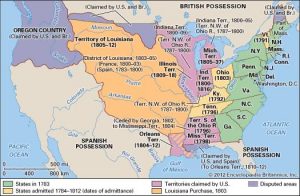 From the time the United States first declared their independence, there was a dispute over the border between the United States and its northern neighbor, Canada. In 1818, the situation finally got to a point whereby a final decision had to be made. It was determined that a convention needed to be held to handle the dispute. The convention, known as the London Convention, Anglo-American Convention of 1818, Convention of 1818, or simply the Treaty of 1818, was to discuss fisheries, boundary and the restoration of slaves between the United States of America and the United Kingdom of Great Britain and Ireland. The Treaty of 1818 was signed during the presidency of James Monroe, and it resolved the boundary between the United States and Canada, then owned by the United Kingdom, once and for all. The treaty allowed for joint occupation and settlement of the Oregon Country, known to the British and in Canadian history as the Columbia District of the Hudson’s Bay Company, and also took in New Caledonia, near Australia.
From the time the United States first declared their independence, there was a dispute over the border between the United States and its northern neighbor, Canada. In 1818, the situation finally got to a point whereby a final decision had to be made. It was determined that a convention needed to be held to handle the dispute. The convention, known as the London Convention, Anglo-American Convention of 1818, Convention of 1818, or simply the Treaty of 1818, was to discuss fisheries, boundary and the restoration of slaves between the United States of America and the United Kingdom of Great Britain and Ireland. The Treaty of 1818 was signed during the presidency of James Monroe, and it resolved the boundary between the United States and Canada, then owned by the United Kingdom, once and for all. The treaty allowed for joint occupation and settlement of the Oregon Country, known to the British and in Canadian history as the Columbia District of the Hudson’s Bay Company, and also took in New Caledonia, near Australia.
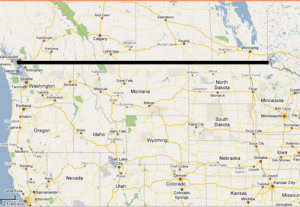
It was ultimately decided that the boundary line should be a straight one, because it would be easier to survey. The prior boundaries were based on watersheds, and were difficult to survey. The treaty marked both the United Kingdom’s last permanent major loss of territory in what is now the Continental United States and the United States’ only permanent significant cession of North American territory to a foreign power. Britain ceded all of Rupert’s Land south of the 49th parallel and west to the Rocky Mountains, including all of the Red River Colony south of that latitude, while the United States ceded the northernmost tip of the territory of Louisiana above the 49th parallel.
 Of course, the prior border from the Great Lakes to the east coast, was already established, so it isn’t straight, but the northwestern border is a straight line. I always thought that was odd, and didn’t know why it was that way. I don’t know if I was not paying attention in history class, which was not my favorite subject in my youth, although I don’t really know why it wasn’t, because now I find it quite fascinating. It’s interesting to find out that the northern border was simply a matter of convenience, and a bit of the barter system, if you will. In order to solve the border war, of sorts, Canada (United Kingdom) gave a little, and the United States gave a little. The end result was a clear cut border, and really, peaceful neighbors. I think the was a good way to settle things.
Of course, the prior border from the Great Lakes to the east coast, was already established, so it isn’t straight, but the northwestern border is a straight line. I always thought that was odd, and didn’t know why it was that way. I don’t know if I was not paying attention in history class, which was not my favorite subject in my youth, although I don’t really know why it wasn’t, because now I find it quite fascinating. It’s interesting to find out that the northern border was simply a matter of convenience, and a bit of the barter system, if you will. In order to solve the border war, of sorts, Canada (United Kingdom) gave a little, and the United States gave a little. The end result was a clear cut border, and really, peaceful neighbors. I think the was a good way to settle things.
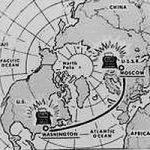 The United States and Russia have long been frenemies, truth be told, but in October of 1962, no one would have called them that. The Cuban Missile Crisis brought the two super powers to the brink of a nuclear conflict. As we all know, that would have been devastating for the inhabitants of the earth, and in the end, both countries agreed that we could not let things escalate to that level again. In June of 1963, American and Russian representatives agreed to establish a “hot line” between Moscow and Washington DC. The idea was to speed communication between the two governments to prevent an accidental war.
The United States and Russia have long been frenemies, truth be told, but in October of 1962, no one would have called them that. The Cuban Missile Crisis brought the two super powers to the brink of a nuclear conflict. As we all know, that would have been devastating for the inhabitants of the earth, and in the end, both countries agreed that we could not let things escalate to that level again. In June of 1963, American and Russian representatives agreed to establish a “hot line” between Moscow and Washington DC. The idea was to speed communication between the two governments to prevent an accidental war.
By August of 1963, the system was ready to be tested. American teletype machines were installed in the Kremlin and at the Pentagon. Many people have thought that the machine at the Pentagon was actually in the White House, but that is incorrect. The two nations exchanged 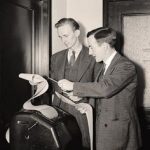 encoding devises so that they could decipher the messages. This would allow the two nations to message each other in a matter of minutes. That would be somewhat slow in today’s high tech world of cell phones and texting, but in those days, it was state of the art. Once received, the message would have to be deciphered, which did slow things down a bit, but again, at that time, it was state of the art. The two teletype machines were connected by a 10,000 mile long cable with “scramblers” along the way to ensure that the messages could not be intercepted by unauthorized personnel.
encoding devises so that they could decipher the messages. This would allow the two nations to message each other in a matter of minutes. That would be somewhat slow in today’s high tech world of cell phones and texting, but in those days, it was state of the art. Once received, the message would have to be deciphered, which did slow things down a bit, but again, at that time, it was state of the art. The two teletype machines were connected by a 10,000 mile long cable with “scramblers” along the way to ensure that the messages could not be intercepted by unauthorized personnel.
On August 30, the United States sent its first message to the Soviet Union over the hot line: “The quick brown fox jumped over the lazy dog’s back 1234567890.” The message was chosen because it used every letter and number key on the teletype machine in order to see that each was in working order. Moscow returned a message in Russian indicating that every key had worked properly. In the end, the hot line was never needed 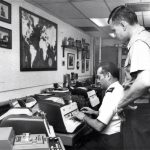 to prevent war, but instead has become a novelty item, used as a prop in movies about nuclear disaster. Fail Safe and Dr Strangelove were two movies that utilized the machines. The reality was that the two superpowers had come so close to mutual destruction back in 1962, that neither had much stomach for the proposed threat. They understood that communication was key in stopping a nuclear war. Of course, that has not stopped other nations from threatening to use nuclear weapons against other nations of the world. The Cold War ended a long time ago, but the “hot line” is still in operation between the two superpowers, and has since been supplemented by a direct secure telephone connection in 1999.
to prevent war, but instead has become a novelty item, used as a prop in movies about nuclear disaster. Fail Safe and Dr Strangelove were two movies that utilized the machines. The reality was that the two superpowers had come so close to mutual destruction back in 1962, that neither had much stomach for the proposed threat. They understood that communication was key in stopping a nuclear war. Of course, that has not stopped other nations from threatening to use nuclear weapons against other nations of the world. The Cold War ended a long time ago, but the “hot line” is still in operation between the two superpowers, and has since been supplemented by a direct secure telephone connection in 1999.

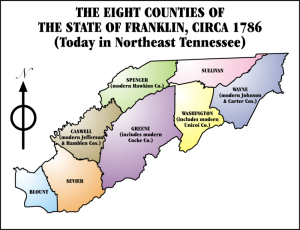 Have you heard of the nation of Frankland…or maybe the nation of Franklin? I hadn’t either, but it was a real place. Early in the history of the United States, its people operated on somewhat limited trust of the government…probably due to the treatment they received in England. In April of 1784, the state of North Carolina ceded its western land claims between the Allegheny Mountains and the Mississippi River to the United States Congress. The settlers who lived in that area, known as the Cumberland River Valley, had already formed their own government from 1772 to 1777, and their distrust of Congress led the to worry that the area might be sold to Spain or France to pay off war debts owed them by the government. Due to their concerns, North Carolina retracted its cession and started to organize an administration for the territory.
Have you heard of the nation of Frankland…or maybe the nation of Franklin? I hadn’t either, but it was a real place. Early in the history of the United States, its people operated on somewhat limited trust of the government…probably due to the treatment they received in England. In April of 1784, the state of North Carolina ceded its western land claims between the Allegheny Mountains and the Mississippi River to the United States Congress. The settlers who lived in that area, known as the Cumberland River Valley, had already formed their own government from 1772 to 1777, and their distrust of Congress led the to worry that the area might be sold to Spain or France to pay off war debts owed them by the government. Due to their concerns, North Carolina retracted its cession and started to organize an administration for the territory.
At the same time, representatives from Washington, Sullivan, Spencer (modern-day Hawkins) and Greene 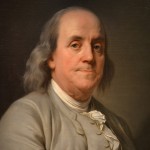 counties declared their independence from North Carolina. Then, in May, they petitioned the United States Congress for statehood as Frankland. The simple majority favored the petition, but Congress could not get the two thirds majority to pass it…not even when the people decided to change the name to Franklin, in the hope of winning favor with Benjamin Franklin and some of the others.
counties declared their independence from North Carolina. Then, in May, they petitioned the United States Congress for statehood as Frankland. The simple majority favored the petition, but Congress could not get the two thirds majority to pass it…not even when the people decided to change the name to Franklin, in the hope of winning favor with Benjamin Franklin and some of the others.
When the petition failed to pass, the people in the area grew angry, and decided to defy Congress. On this day, August 23, 1784, they ceded from the union and functioned as the Free Republic of Franklin (Frankland) for four years. During that time, they had their own constitution, Indian treaties and legislated system of barter in lieu of currency. Two years into the Free Republic of Franklin’s history, North Carolina set up their own parallel government in the area. The economy was weak, and never really gained ground, so the governor, John Sevier approached the Spanish for aid. That move brought a feeling of terror in the government of North Carolina, and they arrested Sevier. The situation worsened when the Cherokee, Chickamauga and Chickasaw began to attack settlements within Franklin’s borders in 1788. Franklin quickly rejoined North Carolina to gain its militia’s protection from attack.
It was a short life for the little nation of Franklin, and eventually they wouldn’t even belong to North Carolina, but rather became a part of the state of Tennessee. It just goes to show that the growing pains of a nation can  take on many forms to reach their destiny as a whole nation. Some changes are good ones, and continue on into the future, and others are not so good, and are sometimes absorbed into the fabric of history and time, and end up looking nothing like the change they started out to be.
take on many forms to reach their destiny as a whole nation. Some changes are good ones, and continue on into the future, and others are not so good, and are sometimes absorbed into the fabric of history and time, and end up looking nothing like the change they started out to be.
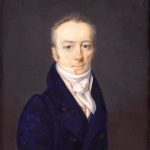
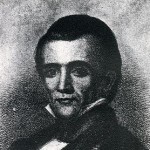 Before Bob and I were even married, I knew that he was related to one of our presidents…namely James Knox Polk. Since then, I have found that we are actually related to several presidents, but James K Polk remains the one with whom the link seems the most obvious. Still, while I knew of the relationship, there were things about him that I didn’t know. One of the most notable being his connection to the Smithsonian Institution. In 1829, one James Smithson died in Italy, and while most people would not think that would have impacted the United States of America, it actually did. So, who was Smithson anyway. Smithson had been a fellow of the venerable Royal Society of London from the age of 22, publishing numerous scientific papers on mineral composition, geology, and chemistry. In 1802, he overturned popular scientific opinion by proving that zinc carbonates were true carbonate minerals, and one type of zinc carbonate was later named Smithsonite in his honor.
Before Bob and I were even married, I knew that he was related to one of our presidents…namely James Knox Polk. Since then, I have found that we are actually related to several presidents, but James K Polk remains the one with whom the link seems the most obvious. Still, while I knew of the relationship, there were things about him that I didn’t know. One of the most notable being his connection to the Smithsonian Institution. In 1829, one James Smithson died in Italy, and while most people would not think that would have impacted the United States of America, it actually did. So, who was Smithson anyway. Smithson had been a fellow of the venerable Royal Society of London from the age of 22, publishing numerous scientific papers on mineral composition, geology, and chemistry. In 1802, he overturned popular scientific opinion by proving that zinc carbonates were true carbonate minerals, and one type of zinc carbonate was later named Smithsonite in his honor.
James Smithson’s will had one odd footnote to it, that in the end, would change everything. Smithson didn’t have much family, in fact, he had just one nephew at the time of his passing. His entire estate was willed to that nephew, with one condition attached to it. If his nephew should die without children, the entire estate was to go to “the United States of America, to found at Washington, under the name of the Smithsonian Institution, an Establishment for the increase and diffusion of knowledge.” Smithson’s curious bequest to a country that he had never visited garnered significant attention on both sides of the Atlantic Ocean. James Smithson was a scientist, who wasn’t well known, but he apparently had a dream for the United States…a country that somehow held his interest. Six years after his death, his nephew, Henry James Hungerford, indeed died without children, and on July 1, 1836, the United States Congress authorized acceptance of Smithson’s gift. President Andrew Jackson sent diplomat Richard Rush to England to negotiate for transfer of the funds, and two years later Rush set sail for home with 11 boxes containing a total of 104,960 gold sovereigns, 8 shillings, and 7 pence, as well as Smithson’s mineral collection, library, scientific notes, and personal effects. After the gold was melted down, it amounted to a fortune worth well over $500,000.
The money was sent to the United States with Smithson’s instructions for its use. It might have seemed like a simple request at the time of the will’s writing, but in the end, the money would sit in the bank waiting for a decade. The reason…a debate on how to use the money. Apparently, even though instructions for the money’s use were given, they did leave a few of the details up to the United States government. Finally, on this day August 10, 1846 James K Polk signed the Smithsonian Institution Act into law. After considering a series of recommendations, including the creation of a national university, a public library, or an astronomical observatory, Congress agreed that the bequest would support the creation of a museum, a library, and a program of research, publication, and collection in the sciences, arts, and history.
Today, the Smithsonian is composed of 19 museums and galleries including the recently announced National Museum of African American History and Culture, nine research facilities throughout the United States and the world, and the national zoo. Besides the original Smithsonian Institution Building, popularly known as the  Castle, visitors to Washington DC, tour the National Museum of Natural History, which houses the natural science collections, the National Zoological Park, and the National Portrait Gallery. The National Museum of American History houses the original Star-Spangled Banner and other artifacts of United States history. The National Air and Space Museum has the distinction of being the most visited museum in the world, exhibiting such marvels of aviation and space history as the Wright brothers’ plane and Freedom 7, the space capsule that took the first American into space. John Smithson, the Smithsonian Institution’s great benefactor, is interred in a tomb in the Smithsonian Building. It has been a pretty amazing use of that money. I think James Smithson would be pleased.
Castle, visitors to Washington DC, tour the National Museum of Natural History, which houses the natural science collections, the National Zoological Park, and the National Portrait Gallery. The National Museum of American History houses the original Star-Spangled Banner and other artifacts of United States history. The National Air and Space Museum has the distinction of being the most visited museum in the world, exhibiting such marvels of aviation and space history as the Wright brothers’ plane and Freedom 7, the space capsule that took the first American into space. John Smithson, the Smithsonian Institution’s great benefactor, is interred in a tomb in the Smithsonian Building. It has been a pretty amazing use of that money. I think James Smithson would be pleased.
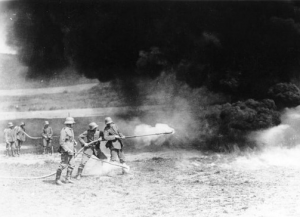 Over the centuries of life on Earth, there have been numerous wars, and numerous weapons of warfare. Yet, few could bring fear to the heart of an infantryman quicker than the Flammenwerfer. Developed by the Germans during World War I, the Flammenwerfer…or Flamethrower, in English…once lit could throw a steady stream of flames 20 to 30 feet in front of it. For the men on the ground, this meant one of two things. They could run…abandoning the relative safety of their foxhole, usually with the result of being shot down by the enemy, or they could stand their ground and be incinerated. It wasn’t much of a choice really, and most ran in the hope of escaping the machine gun fire that would undoubtedly follow the flamethrower. It was a situation of instant death…no matter which choice a soldier made…not to mention the fact that every fiber of a soldier’s being and training told them to stand their ground. This weapon took much of it toll on the soldier’s sense of bravery.
Over the centuries of life on Earth, there have been numerous wars, and numerous weapons of warfare. Yet, few could bring fear to the heart of an infantryman quicker than the Flammenwerfer. Developed by the Germans during World War I, the Flammenwerfer…or Flamethrower, in English…once lit could throw a steady stream of flames 20 to 30 feet in front of it. For the men on the ground, this meant one of two things. They could run…abandoning the relative safety of their foxhole, usually with the result of being shot down by the enemy, or they could stand their ground and be incinerated. It wasn’t much of a choice really, and most ran in the hope of escaping the machine gun fire that would undoubtedly follow the flamethrower. It was a situation of instant death…no matter which choice a soldier made…not to mention the fact that every fiber of a soldier’s being and training told them to stand their ground. This weapon took much of it toll on the soldier’s sense of bravery.
The Flammenwerfer was developed in 1915 by the Germans, and first used in battle against the Allied forces on this day, July 30, 1915 at the Battle of Hooge. Eleven days before that battle, British infantry had captured the German occupied village of Hooge, located near Ypres in Belgium, by detonating a large mine. Using the flamethrowers, along with machine guns, trench mortars and hand grenades, the Germans got their positions 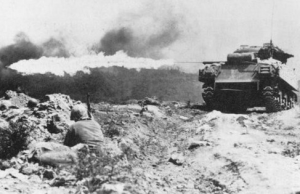 back on July 30, 1915. They broke through enemy front lines with ease, pushing the British forces back to their second trench. Only a few men were lost to actual burns, but a British officer was heard to explain that the weapons had a great demoralizing effect, and when added to the assault of the other powerful weapons, they proved mercilessly efficient at Hooge. I suppose that is true. I can think of few things more demoralizing for a soldier than running from your position in fear. Soldiers don’t take kindly to fear…or running away.
back on July 30, 1915. They broke through enemy front lines with ease, pushing the British forces back to their second trench. Only a few men were lost to actual burns, but a British officer was heard to explain that the weapons had a great demoralizing effect, and when added to the assault of the other powerful weapons, they proved mercilessly efficient at Hooge. I suppose that is true. I can think of few things more demoralizing for a soldier than running from your position in fear. Soldiers don’t take kindly to fear…or running away.
During World War I, the Germans were the only ones to use such a weapon, and not because it was difficult to make. So, why didn’t the Allies us it too? It was one of the great puzzles that emerged from World War I. Why? The British made three attempts with larger, more unwieldy prototypes: the smallest one was equal in size to the German Grof, which the enemy had almost abandoned by 1916. The French were more persistent, and by 1918 had at least seven companies trained in using flamethrowers, and still the use of the weapon never progressed to the same level as that of the German army.
By World War II, however, the flamethrower was the most dramatic hand weapon used by any Army and the most effective for its purpose. But it was during the 20th century that engineers and scientists placed flames 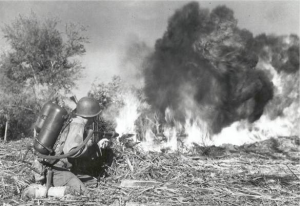 under advanced technological control in an effort to make flamethrowers portable, reliable and reasonably safe…for the user anyway. Prior to that the words “friendly fire” had a second meaning in that flamethrowers could kill the operator while he was doing his best to kill the enemy with it. The result of this new technology was a device with as much psychological impact as it’s lethality impact. That was the chief reason why the United States, Great Britain and other world powers used the flamethrower from World War I through the Vietnam War. Even today, Russia still has flamethrowers in its inventory. I guess it is an important weapon, but for most of us, I think that just the thought of using it on someone would make us seriously ill.
under advanced technological control in an effort to make flamethrowers portable, reliable and reasonably safe…for the user anyway. Prior to that the words “friendly fire” had a second meaning in that flamethrowers could kill the operator while he was doing his best to kill the enemy with it. The result of this new technology was a device with as much psychological impact as it’s lethality impact. That was the chief reason why the United States, Great Britain and other world powers used the flamethrower from World War I through the Vietnam War. Even today, Russia still has flamethrowers in its inventory. I guess it is an important weapon, but for most of us, I think that just the thought of using it on someone would make us seriously ill.
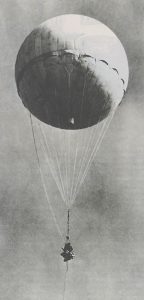 I suppose a true World War II history buff might know about some of the strange war stories there are out there, and I rather thought I was becoming a World War II history buff, but I had never heard of the Japanese Balloon Bombs. I can’t imagine how a nation could send a random bomb over another nation, not knowing where it will land, or who it will kill…but then, the evil we have seen in the 21st century has proven to be very much the same. I guess there really is nothing new under the sun. Where evil exists, horrible things happen. Such was the case with the Japanese Balloon Bombs. The Japanese were an evil nation at that time, and they didn’t care who they hurt. in 1945, a Japanese Balloon Bomb landed in rural Oregon, ad killed six people . As it turns out, these were the only World War II combat casualties within the continental 48 states. Apparently, the accuracy of the balloon bombs left something to be desired…thankfully.
I suppose a true World War II history buff might know about some of the strange war stories there are out there, and I rather thought I was becoming a World War II history buff, but I had never heard of the Japanese Balloon Bombs. I can’t imagine how a nation could send a random bomb over another nation, not knowing where it will land, or who it will kill…but then, the evil we have seen in the 21st century has proven to be very much the same. I guess there really is nothing new under the sun. Where evil exists, horrible things happen. Such was the case with the Japanese Balloon Bombs. The Japanese were an evil nation at that time, and they didn’t care who they hurt. in 1945, a Japanese Balloon Bomb landed in rural Oregon, ad killed six people . As it turns out, these were the only World War II combat casualties within the continental 48 states. Apparently, the accuracy of the balloon bombs left something to be desired…thankfully.
The idea of a balloon bomb was to send in a bomb that was silent. The problem is that balloons are hard to control. They go with the flow of the wind currents, so you don’t know where they will land. Then again, the Japanese were at war with the world, so they really didn’t care where the balloons would land. The six people who were killed by the Fu-Go or fire-balloon bomb, as they were called, were a Sunday School teacher Elyse Mitchell (and her unborn child), her 13 and 14 year old students, Jay Gifford, Edward Engen, Sherman Shoemaker, Dick Patzke, all of whom were killed instantly, when the bomb exploded. Dick Patzke’s sister, Joan was severely burned, and died moments later. The group had stopped for a moment, because Elyse Mitchell was feeling ill, and while her husband, Reverend Archie Mitchell talked with construction workers in the area, the six victims went to investigate a balloon they saw. It would prove to be a fatal mistake. The group had been going on a Saturday afternoon picnic near Klamath Falls, Oregon. They had only walked about 100 yards from the car. One of the road-crew workers, Richard Barnhouse, said “There was a terrible explosion. Twigs flew through the air, pine needles began to fall, dead branches and dust, and dead logs went up.”
Made of rubberized silk or paper, each balloon was about 33 feet in diameter. Barometer-operated valves released hydrogen if the balloon gained too much altitude or dropped sandbags if it flew too low. The balloons were filled with 19,000 cubic feet of hydrogen and the jet stream drew them eastward. They were designed to travel across the Pacific to North America, where they would drop incendiary devices or anti-personnel explosives. I would think the hydrogen alone would make a horrible bomb, but attached to the 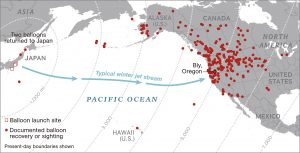 balloon was the actual bomb. The Japanese released an estimated 9,000 fire balloons during the last months of World War II. At least 342 reached the United States, with some drifting as far as Nebraska. Some were shot down. Some caused minor damage when they landed, but no injuries. One hit a power line and blacked out the nuclear-weapons plant at Hanford, Washington. But the only known casualties from the 9,000 balloons…and the only combat deaths from any cause on the U S mainland were the five kids and their Sunday school teacher going to a picnic. What a valiant victory for the Japanese that was.
balloon was the actual bomb. The Japanese released an estimated 9,000 fire balloons during the last months of World War II. At least 342 reached the United States, with some drifting as far as Nebraska. Some were shot down. Some caused minor damage when they landed, but no injuries. One hit a power line and blacked out the nuclear-weapons plant at Hanford, Washington. But the only known casualties from the 9,000 balloons…and the only combat deaths from any cause on the U S mainland were the five kids and their Sunday school teacher going to a picnic. What a valiant victory for the Japanese that was.
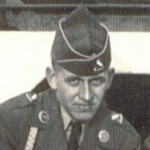 On June 25, 1950, when North Korea invaded South Korea, my uncle, Larry Byer found himself in the middle of what would become some of the hardest years of his life. Uncle Larry was an Army private during the Korean War. Korea was originally under the rule of the Japanese empire, but when it collapsed after World War II, the country was divided. The United Nations, using the United States as its main force, came to aid of South Korea. China, along with assistance from Soviet Union, came to aid of North Korea. North Korea was unhappy with the division of the country that took place after World War II. The global tensions of the Cold War that developed immediately afterwards didn’t help the situation either. Then the North Korean government decided
On June 25, 1950, when North Korea invaded South Korea, my uncle, Larry Byer found himself in the middle of what would become some of the hardest years of his life. Uncle Larry was an Army private during the Korean War. Korea was originally under the rule of the Japanese empire, but when it collapsed after World War II, the country was divided. The United Nations, using the United States as its main force, came to aid of South Korea. China, along with assistance from Soviet Union, came to aid of North Korea. North Korea was unhappy with the division of the country that took place after World War II. The global tensions of the Cold War that developed immediately afterwards didn’t help the situation either. Then the North Korean government decided  to get back the area they believed was actually theirs. In reality, Korea isn’t the only country ever to be divided, so had they simply accepted it, the problem might have been resolved right away, but they simply wouldn’t.
to get back the area they believed was actually theirs. In reality, Korea isn’t the only country ever to be divided, so had they simply accepted it, the problem might have been resolved right away, but they simply wouldn’t.
I understand why something had to be done with the country of Korea, because they had no government, but it doesn’t seem right to me to divide the country. Nevertheless, it was done that way, and in reality, that area has been volatile since that day. North Korea has tried to take over South Korea. They have also made many threats to the rest of the world. Their leader, Kim Jong-il, and now his son, Kim Jong-un, have both proven to be ruthless, and about half crazy. The rest of the world is  constantly trying to decide if we need to go in an blow them up, or try not to make them too angry. Time will tell, and it depends on Kim Jong-un.
constantly trying to decide if we need to go in an blow them up, or try not to make them too angry. Time will tell, and it depends on Kim Jong-un.
This was the world my Uncle Larry found himself in while he was a private in the Army. The North Koreans fought their battles in any underhanded way they could come up with. Their only goal was to win the war. They didn’t of course, and soon, my Uncle Larry came back home. I’m sure he was very happy to be back home. Spending any time in a crazy war like the Korean war would never be ideal in any way. I am just thankful that he made it home. Today is Uncle Larry’s birthday. He would have been 82 years old. Happy birthday in Heaven Uncle Larry. We love and miss you very much.
 These days there are so many public schools in the United States, that they have become something we give little thought to. That was not always the case, however. As people moved West to populate this great nation, many mothers had to homeschool their children. Eventually, schools began to spring up across the prairie, but what about the schools back East. This nation didn’t always have schools. Things had to be established first. And considering the fact that America was discovered in 1492, it would seem to me that the schools were a bit behind the times. The first public school in the United States, was established on this day, April 23, 1635, in Boston, Massachusetts. The school was called the Boston Latin School. At the time the school was formed, English was not the only language spoken in the United States, so learning Latin, which was considered to be the root of European language, was also a priority, as it was with grammar schools in
These days there are so many public schools in the United States, that they have become something we give little thought to. That was not always the case, however. As people moved West to populate this great nation, many mothers had to homeschool their children. Eventually, schools began to spring up across the prairie, but what about the schools back East. This nation didn’t always have schools. Things had to be established first. And considering the fact that America was discovered in 1492, it would seem to me that the schools were a bit behind the times. The first public school in the United States, was established on this day, April 23, 1635, in Boston, Massachusetts. The school was called the Boston Latin School. At the time the school was formed, English was not the only language spoken in the United States, so learning Latin, which was considered to be the root of European language, was also a priority, as it was with grammar schools in 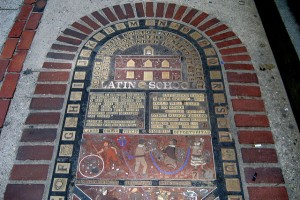 England. Seventeenth-century schoolboys throughout Europe, Catholic or Protestant, learned Latin, and which explains the focus of Boston Latin.
England. Seventeenth-century schoolboys throughout Europe, Catholic or Protestant, learned Latin, and which explains the focus of Boston Latin.
One of the main reasons for education, as far as the Puritans were concerned, was to be able to read the Bible. One of the main reasons for the pilgrimage to the new world was religious freedom, and they felt like it was essential that their students be schooled in the important languages, so they could read the Bible and other important books for themselves. Boston Latin School has prided itself on the number of its students who attended Harvard, or some of the other prestigious four year college.
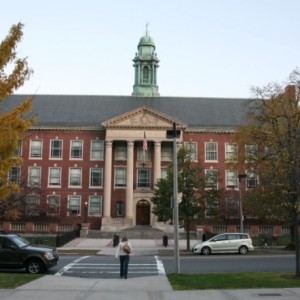 When I think of the first school in the United States, and the history thereof, I think of my Aunt Bertha Schumacher Hallgren. She mentioned in her journal that in writing a family history, the author should mention things that are interesting about the times the people in the family lived in. She also had a type of love-hate relationship with school. As a young girl, all she really wanted to do was to stay at home with her mother, but she also understood the importance of a good education, for without it she would not have been able to get the jobs she was able to get, which were good jobs, especially for a woman at that time in history. Whether we enjoy school or not, it is a gateway to almost every opportunity there is, and in the United States, it started with Boston Latin School.
When I think of the first school in the United States, and the history thereof, I think of my Aunt Bertha Schumacher Hallgren. She mentioned in her journal that in writing a family history, the author should mention things that are interesting about the times the people in the family lived in. She also had a type of love-hate relationship with school. As a young girl, all she really wanted to do was to stay at home with her mother, but she also understood the importance of a good education, for without it she would not have been able to get the jobs she was able to get, which were good jobs, especially for a woman at that time in history. Whether we enjoy school or not, it is a gateway to almost every opportunity there is, and in the United States, it started with Boston Latin School.
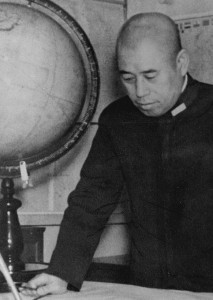 Some soldiers, no matter what side they are on or what branch of service they are in, are so good at what they do, that they become a must kill to the enemy. Admiral Isoroku Yamamoto was just such a soldier. Yamamoto held several important posts in the Imperial Japanese Navy, and undertook many of its changes and reorganizations, especially its development of naval aviation. He was the commander-in-chief during the early years of the Pacific War and so was responsible for major battles such as Pearl Harbor and Midway. That meant that the Unites States had a score to settle with the admiral. Nevertheless, this would be no easy task. The Japanese codes were difficult to break, and so locating the admiral at a time when they could be prepared to shoot him down was not going to be easy.
Some soldiers, no matter what side they are on or what branch of service they are in, are so good at what they do, that they become a must kill to the enemy. Admiral Isoroku Yamamoto was just such a soldier. Yamamoto held several important posts in the Imperial Japanese Navy, and undertook many of its changes and reorganizations, especially its development of naval aviation. He was the commander-in-chief during the early years of the Pacific War and so was responsible for major battles such as Pearl Harbor and Midway. That meant that the Unites States had a score to settle with the admiral. Nevertheless, this would be no easy task. The Japanese codes were difficult to break, and so locating the admiral at a time when they could be prepared to shoot him down was not going to be easy.
Finally, on April 18, 1943, the code breakers successfully broke the code, leaving the admiral vulnerable to attack, and Operation Vengence was born. The sole purpose of this mission was to kill Admiral Isoroku Yamamoto. The mission took place during the Solomon Islands campaign in the Pacific Theater of World War II. The code breakers found out that the admiral was set to be onboard a transport plane that would be flying over Bougainville Island. With everything finally in place, his transport bomber aircraft was shot down by United States Army Air Forces fighter aircraft operating from Kukum Field on Guadalcanal. It was a day to celebrate. The United States had been nursing a black eye where Pearl Harbor was concerned, and they had been looking to settle the score. Operation Vengence was the victory they had been waiting for.
The admiral’s death was a major blow to Japanese  military morale during World War II, and was a major boost to the Allied Forces. The operation was intended as revenge for the Pearl Harbor attack which initiated the formal state of war between Imperial Japan and the United States.
military morale during World War II, and was a major boost to the Allied Forces. The operation was intended as revenge for the Pearl Harbor attack which initiated the formal state of war between Imperial Japan and the United States.
After the war, there was debate over which of the US fighter pilots involved in the raid deserved the official credit for downing Yamamoto due to conflicting first-hand reports from the participants, and has never been entirely resolved. I suppose that for the pilots it was a big deal, but for the US citizens it wasn’t the pilot that mattered, but rather that the mission had been successful. Americans hate to lose, and we will go after the villan who dared to attack us.

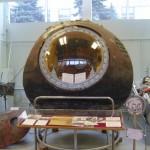 Many things changed on the day, Jennifer Schulenberg Parmely, my sister-in-law, was born. No, it wasn’t something that she or her parents did, but rather in the world. On this day, April 12, in 1961, the year Jennifer was born, the world saw it’s very first manned space flight. That was the day that the Race to Space ended with Russia putting the first man in space. That man was Yuri Gagarin. The United States had hoped to win that race, but we were not ready to put our first manned space flight into space for another month. I’m sure that all this meant nothing to Jennifer, or her parents, Walt and Joann Schulenberg, but it is, nevertheless, a historical fact, and it happend on the day she was born.
Many things changed on the day, Jennifer Schulenberg Parmely, my sister-in-law, was born. No, it wasn’t something that she or her parents did, but rather in the world. On this day, April 12, in 1961, the year Jennifer was born, the world saw it’s very first manned space flight. That was the day that the Race to Space ended with Russia putting the first man in space. That man was Yuri Gagarin. The United States had hoped to win that race, but we were not ready to put our first manned space flight into space for another month. I’m sure that all this meant nothing to Jennifer, or her parents, Walt and Joann Schulenberg, but it is, nevertheless, a historical fact, and it happend on the day she was born.
Jennifer grew up, and became the mother of three boys, Barry, JD, and Eric. There was hope that she would have a daughter, but that was not to be. It seemed to be some kind of tradition in the Schulenberg family…at least with the grandchildren and great grandchildren. Whatever the first baby was, the others in that family were the same. The only one to break that tradition to date is my daughter Amy Royce, who managed to have a girl and then, shocker…a boy. All the others in the family have one or the other. That didn’t leave Jennifer much hope of having a granddaughter either, but Eric and his wife, Ashley broke with the boy tradition in Jennifer’s family and had two girls, Reagan and Hattie. They still kept with the tradition of what the first one is the others are too, however. Of course, there is always a possibility that they will try again for the boy, and maybe…just maybe, they will succeed like Amy did. Until that time, Jennifer is enjoying the little girls she never got to have, and that is very nice for her, because they are little sweeties, for sure.
Jennifer is a nurse at Wyoming Medical Center, and has worked there since she was just seventeen. She 
 started as a Candy Striper, and after college, was hired in the Obstetrics department as a nurse. She has always loved newborn babies, and this way she gets to see lots of them, but the good news is that she can hold them and then give them back to their mothers, because as most mothers know, there is a time to have your babies, and a time to be the one to just spoil those babies and let their parents handle the fallout. It’s called being the grandma, and believe me, it’s awesome, as any grandmother will tell you. Today is Jennifer’s birthday. Happy birthday Jennifer!! Have a great day!! We love you!!
started as a Candy Striper, and after college, was hired in the Obstetrics department as a nurse. She has always loved newborn babies, and this way she gets to see lots of them, but the good news is that she can hold them and then give them back to their mothers, because as most mothers know, there is a time to have your babies, and a time to be the one to just spoil those babies and let their parents handle the fallout. It’s called being the grandma, and believe me, it’s awesome, as any grandmother will tell you. Today is Jennifer’s birthday. Happy birthday Jennifer!! Have a great day!! We love you!!

